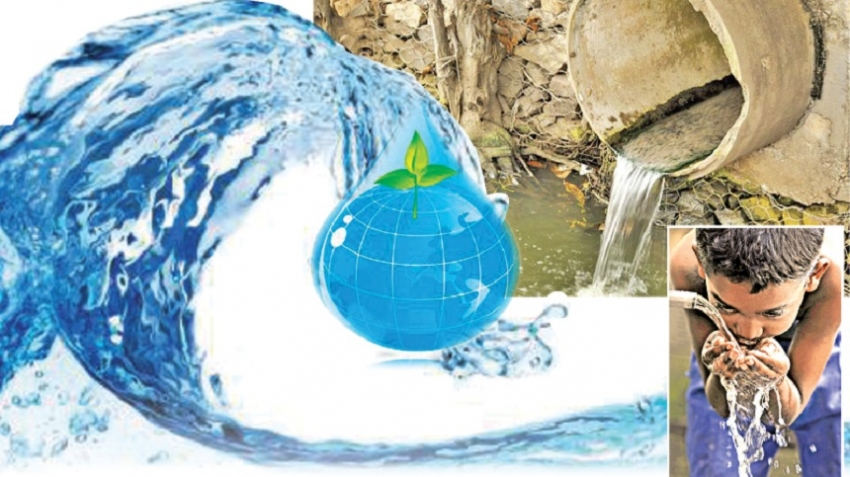The world faces an invisible crisis of water quality. Its impacts are wider, deeper, and more uncertain than previously thought and require urgent attention.While much attention has focused on water quantity – too much water, in the case of floods; too little water, in the case of droughts – water quality has attracted significantly less consideration. The Quality Unknown shows that urgent attention must be given to the hidden dangers that lie beneath the water’s surface:
Water quality challenges are not unique to developing countries but universal across rich and poor countries alike. High-income status does not confer immunity - challenges with pollutants grow alongside Gross Domestic Product (GDP). And, as countries develop, the cocktail of chemicals and vectors they contend with change – from faecal bacteria to nitrogen to pharmaceuticals and plastics, for example.
What we think of as safe may be far from it. Water quality is complex and its impacts on health and other sectors are still largely uncertain. Worse, regulations guiding safety standards are often fragmented across countries and agencies, thus adding to this uncertainty. This report shows that some pollutants in water have impacts that were previously unknown and occur at levels below established safe norms.
The forces driving these challenges are accelerating. Intensification of agriculture, land use changes, more variable rainfall patterns due to climate change and growing industrialisation due to countries’ development all continue to grow. This means increasing number of algal blooms in water which are deadly for humans and ecosystems alike.
Poor water quality threatens growth, harms public health and imperils food security.
Using new data, this report demonstrates the importance of water quality across a range of sectors and how its impacts cut across nearly all of the SDGs. Poor water quality stalls economic progress, stymies human potential and reduces food production: Water pollution endangers economic growth. The release of pollution upstream acts as a headwind that lowers economic growth downstream.
When Biological Oxygen Demand (BOD) – a measure of how much organic pollution is in water and a proxy measure of overall water quality – passes a certain threshold, GDP growth in downstream regions is lowered by a third.
In middle-income countries – where BOD is a growing problem because of increased industrial activity - GDP growth downstream of highly polluted areas drops by half.
There are a number of reasons for this, including:
* Nitrogen in water shortens people and shortens their lives. Much of the nitrogen applied as fertiliser eventually enters rivers, lakes and oceans where it transforms into nitrates. Nitrates in water are responsible for fatally inflicting Blue Baby Syndrome, which starves infants’ bodies of oxygen. This report finds that those who survive the consequences of early exposure to nitrates can be condemned to long-term damages throughout their lives – they grow up shorter and earn less than they would have otherwise. Stunting is a red flag indicator for the risk of physical and cognitive deficits.
* Nitrate exposure in infancy: wipes out much of the gain in height seen over the past half-century in some regions and harms children even in areas where nitrate levels are deemed safe.
While an additional kilogramme of nitrogen fertilizer per hectare increases agricultural yields by as much as five percent, the accompanying run-off and releases into the water can increase childhood stunting by as much as 19 percent and decrease adult earnings by as much as two percent. This suggests a stark trade-off between using nitrogen to boost agricultural output and reducing its use to protect children’s health. Salinity diminishes agricultural productivity. Saline waters and soils are spreading throughout much of the world because of increasing rates of water extraction, droughts and rainfall shocks, sea-level rise, and poorly managed irrigation systems. This report shows that agricultural yields fall almost exactly in line with increased salt concentrations in water. That is to say – more salt in the water means less food for the world. This report also reveals that enough food is lost due to saline waters each year to feed 170 million people every day – that is equivalent to a country the size of Bangladesh. Such a sizable loss of food production to saline waters means food security will continue to be jeopardised unless action is taken. Even as these impacts are being felt, emerging pollutants are entering the world’s waters – their impacts are still unknown, but present a hazard that may further exacerbate existing problems.
The outlook is stark - but change is possible. Increased awareness, strengthened prevention and smart investments using new technology are needed to turn back the tide of water pollution.
The challenge is daunting, but it is not insurmountable. Solutions exist for countries at all stages of development. The way forward requires a mix of approaches that focus on information, prevention and investment: Information is both a resource and a rallying cry. The first step to tackling the water quality challenge is recognising the scale of it. The world needs reliable, accurate and comprehensive information so that new insights can be discovered, decision-making can be evidence-based and citizens can call for action. Encouraging and enabling this information and its sharing is critical to getting water pollution under control. Prevention is better than cure.
While sunlight may be the best disinfectant, legislation, implementation and enforcement are also crucial to scrub the world’s waterways of pollution. Information and transparency must be coupled with well-designed, effectively implemented and scrupulously enforced regulations for firms and individuals to adhere to water quality guidelines. Invest in what works. Pollution that cannot be prevented must be treated. Wastewater treatment has a vital role to play – it is crucial for a country’s health, food security and economy by helping remove pollution and debris. Investments in wastewater treatment are a down payment on a cleaner future.
(The World Bank)
****
The world faces an invisible crisis of water quality that is eliminating one-third of potential economic growth in heavily polluted areas and threatening human and environmental well-being, according to a World Bank report.
The Quality Unknown: The Invisible Water Crisis shows, with new data and methods, how a combination of bacteria, sewage, chemicals, and plastics can suck oxygen from water supplies and transform water into poison for people and ecosystems. To shed light on the issue, the World Bank assembled the world’s largest database on water quality gathered from monitoring stations, remote sensing technology, and machine learning.
The report finds that a lack of clean water limits economic growth by one-third. It calls for immediate global, national, and local-level attention to these dangers which are faced by both developed and developing countries.
“Clean water is a key factor for economic growth. Deteriorating water quality is stalling economic growth, worsening health conditions, reducing food production, and exacerbating poverty in many countries,” World Bank Group President David Malpass said. “Their governments must take urgent action to help tackle water pollution so that countries can grow faster in equitable and environmentally sustainable ways.”
When BOD – a measure of how much organic pollution is in water and a proxy measure of overall water quality – crosses a certain threshold, GDP growth in downstream regions drops by as much as a third because of impacts on health, agriculture, and ecosystems.
A key contributor to poor water quality is nitrogen, which, applied as fertiliser in agriculture, eventually enters rivers, lakes and oceans where it transforms into nitrates. Early exposure of children to nitrates affects their growth and brain development, impacting their health and adult earning potential. The run-off and release into the water from every additional kilogramme of nitrogen fertiliser per hectare can increase the level of childhood stunting by as much as 19 percent and reduce future adult earnings by as much as two percent, compared to those who are not exposed.
The report also finds that as salinity in the water and soil increases due to more intense droughts, storm surges and rising water extraction, agricultural yields fall. The world is losing enough food to saline water each year to feed 170 million people.
The report recommends a set of actions that countries can take to improve water quality.
These include: environmental policies and standards; accurate monitoring of pollution loads; effective enforcement systems; water treatment infrastructure supported with incentives for private investment; and reliable, accurate information disclosure to households to inspire citizen engagement.



















